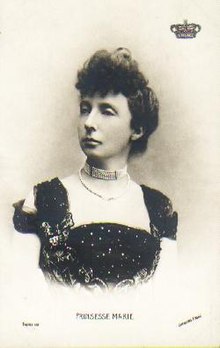Marie d'Orléans
Marie Amélie Françoise Hélène d'Orléans (born January 13, 1865 in Ham, England , † December 4, 1909 in Copenhagen , Denmark ) was a French princess and, by marriage, Princess of Denmark.
family
Marie d'Orléans was the eldest daughter of Prince Robert , and his wife Françoise d'Orléans and thus granddaughter of the last French king, Louis-Philippe I . She had four younger siblings, including Jean, duc de Guise , French pretender to the throne, who was also referred to as "Jean III" by his followers.
Marie was born in exile in England, to which her family had fled in 1848. Only after the fall of Napoleon III. In 1871 she moved to France with her family.
Life
marriage
Marie d'Orléans married Prince Waldemar of Denmark , the youngest son of King Christian IX. of Denmark , on October 20, 1885 in a civil wedding in Paris , followed two days later by a church wedding in the Château d'Eu . The couple were fourth cousins. Marie did not convert to the Lutheran faith, but kept the Roman Catholic faith. Marie and Waldemar followed the dynastic rule in such cases that sons should be brought up in the faith of their father and daughters in the faith of their mother.
The couple lived in Bernstorff Castle , outside of Copenhagen, where Waldemar was born. Waldemar had already lived there with his nephew and ward Prince Georg of Greece , a younger son of his brother Vilhelm, who had become King of the Hellenes as George I in 1863 . Georg had come to Denmark to join the Danish Navy and was placed under the protection of Waldemar, who was an admiral in the Danish fleet. Georg was later to write to his fiancée, Marie Bonaparte , that he had had a deep bond with his uncle Waldemar ever since.
character
Marie was described as impulsive, active, and witty, and brought a more relaxed style to the stiff Danish court. She should never speak Danish fluently. The couple got along well. Marie granted her children a free childhood, her artistic tastes and unconventional customs dominating the household. Marie was very informal, stood up for social justice and expressed her opinion publicly. She enjoyed riding and was the official patroness of the fire brigade, which is why she was photographed in a fire brigade uniform. She also supported her husband's marine career and had an anchor tattooed on her upper arm.
Marie had also obtained permission from the court to leave the house without a lady-in-waiting and spent most of her time with artists. She painted and photographed and was a student of Otto Bache and Frants Henningsen. Marie took part in exhibitions in Charlottenborg in 1889, 1901 and 1902 and was a member of the Danish Art Academy.
Contrary to what was expected of the women of the royal family, Marie was interested in politics. With their consent, Waldemar did not accept the Bulgarian throne in 1886. Marie belonged to the political left and influenced the king to adopt the reforms of 1901, which led to the appointment of a Venstre government and the de facto introduction of parliamentarism . Marie also campaigned for French interests, among other things, she was credited by the French press with influencing the Franco-Russian alliance in 1894 and the peace in the Franco-German colonial conflict over Morocco in 1905.
Marie died on December 4, 1909 in Bernstorff, while her husband and three of their sons were in India.
progeny
From her marriage to Prince Waldemar of Denmark, Marie d'Orléans had five children:
- Prince Aage of Denmark (1887-1940); Count of Rosenborg , ∞ Mathilda Calvi dei Conti di Bergolo
- Prince Axel of Denmark (1888–1964); ∞ Princess Margaretha of Sweden
- Prince Erik of Denmark (1890–1950); Count of Rosenborg, ∞ Lois Frances Booth
- Prince Viggo of Denmark (1893-1970); Earl of Rosenborg, ∞ Eleanor Margaret Green
- Princess Margaretha of Denmark (1895-1992); Prince Renato of Bourbon-Parma. Their daughter Anna became Queen of Romania.
Afterlife
Princess Marie is remembered by a memorial in Langelinie, Copenhagen. It was erected in 1912 and shows a bust made by Carl Martin-Hansen. In addition, the Prinsesse Maries Hjem for gamle Sømænd og Sømænds Enker (Princess Marie Home for old sailors and widows of sailors) in Christianshavn and the Prinsesse Maries Allé in Frederiksberg were named after her.
In 1883, the Marie d'Orléans rose cultivation was named after her.
Titles and honors
title
- January 13, 1865 - October 22, 1885: Her Royal Highness Princess Marie d'Orléans
- October 22, 1885 - December 4, 1909: Her Royal Highness Princess Waldemar of Denmark
Honors
![]() Lady of the Order of St. Elizabeth
Lady of the Order of St. Elizabeth
- Denmark
![]() Lady of the Order of Dannebrog
Lady of the Order of Dannebrog
Individual evidence
- ↑ Celia Bertin: A False Happiness. Marie Bonaparte: A Life . New York 1982, p. 85-86 .
- ↑ Helen Lewis: Will a tattoo ever hang in the Louvre? In: NewStatesman. April 24, 2013, accessed August 14, 2020 .
- ↑ a b c Tinne Vammen: Marie (1865 - 1909) Marie Amélie Francoise Hélène . In: Dansk Kvindebiografisk Leksikon . 2003.
- ↑ Celia Bertin: A False Happiness, Marie Bonaparte: A Life . S. 102 .
| personal data | |
|---|---|
| SURNAME | Orléans, Marie d ' |
| ALTERNATIVE NAMES | Orléans, Marie Amélie Françoise Hélène d ' |
| BRIEF DESCRIPTION | French princess, princess of Denmark |
| DATE OF BIRTH | January 13, 1865 |
| PLACE OF BIRTH | Ham, England |
| DATE OF DEATH | 4th December 1909 |
| Place of death | Copenhagen , Denmark |


